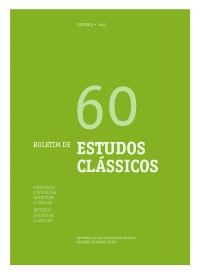Please use this identifier to cite or link to this item:
https://hdl.handle.net/10316.2/41485| DC Field | Value | Language |
|---|---|---|
| dc.contributor.author | Vieira, Brunno V. G. | - |
| dc.date.accessioned | 2017-04-27T16:21:07Z | |
| dc.date.accessioned | 2020-09-21T05:30:52Z | - |
| dc.date.available | 2017-04-27T16:21:07Z | |
| dc.date.available | 2020-09-21T05:30:52Z | - |
| dc.date.issued | 2015 | - |
| dc.identifier.issn | 0872-2110 | - |
| dc.identifier.issn | 2183-7260 (PDF) | - |
| dc.identifier.uri | https://hdl.handle.net/10316.2/41485 | - |
| dc.description.abstract | A diferente modulação estilística de Bocage e Filinto Elísio ao traduzir o poeta épico latino Lucano (séc. I d. C.) manifesta duas vertentes distintas entre as práticas de tradução literária lusófona do séc. xviii em diante. Cada um desses poetas oferece nas suas versões de Lucano um resultado estético singular: Bocage privilegia a língua de chegada e procura acomodar o latim às leis de naturalidade, clareza e simplicidade sob as quais ele próprio praticava poesia; Filinto Elísio procura uma tradução mais literal do poeta latino, preservando elementos do texto de partida tanto no nível lexical como no nível sintagmático, seguindo de perto as dificuldades e obscuridades próprias do poema de Lucano. Essas duas maneiras de traduzir refletem vertentes literárias e estéticas, identificadas já por Garrett, que ficaram conhecidas posteriormente por Elmanismo e Filintismo. | por |
| dc.description.abstract | The different Bocage and Filinto Elísio’s stylistic modulation in translating the Latin epic poet Lucan (1st Century AD) expresses two different practices between Lusophone literary translation from the xviii century. Each one of these poets offers in their own versions of Lucan a singular aesthetic result: Bocage privileges the target language and seeks to accommodate the Latin to the laws of naturalness, clarity and simplicity under which he himself practiced poetry; Filinto Elísio looks for a more literal translation to the Latin poet, preserving elements of the source text at both the lexical and syntagmatic level, closely following the peculiar difficulties and obscurities of the Lucan’s poem. These two ways of translating reflect literary and aesthetic aspects, already identified by Garrett, which later became known as Elmanismo and Filintismo. | eng |
| dc.language.iso | por | - |
| dc.publisher | Imprensa da Universidade de Coimbra | - |
| dc.rights | open access | - |
| dc.subject | Bocage | eng |
| dc.subject | Filinto | eng |
| dc.subject | Lucan | eng |
| dc.subject | translation studies | eng |
| dc.subject | Bocage | por |
| dc.subject | Filinto | por |
| dc.subject | Lucano | por |
| dc.subject | estudos de tradução | por |
| dc.title | Bocage e Filinto: duas maneiras de traduzir os clássicos | por |
| dc.title.alternative | Bocage and Filinto: two ways of translating classics | por |
| dc.type | article | - |
| uc.publication.collection | Boletim de Estudos Clássicos vol. 60 | - |
| uc.publication.firstPage | 167 | - |
| uc.publication.lastPage | 179 | - |
| uc.publication.location | Coimbra | - |
| uc.publication.journalTitle | Boletim de Estudos Clássicos | - |
| uc.publication.volume | 60 | por |
| dc.identifier.doi | 10.14195/0872-2110_60_12 | - |
| uc.publication.section | Tradição Clássica | - |
| uc.publication.orderno | 13 | - |
| uc.publication.area | Artes e Humanidades | - |
| uc.publication.manifest | https://dl.uc.pt/json/iiif/10316.2/41485/229165/manifest?manifest=/json/iiif/10316.2/41485/229165/manifest | - |
| uc.publication.thumbnail | https://dl.uc.pt/retrieve/11437901 | - |
| item.grantfulltext | open | - |
| item.fulltext | With Fulltext | - |
| Appears in Collections: | Boletim de Estudos Clássicos | |
Files in This Item:
| File | Description | Size | Format | |
|---|---|---|---|---|
| bocage_e_filinto.pdf | 266.46 kB | Adobe PDF |  |
Items in DSpace are protected by copyright, with all rights reserved, unless otherwise indicated.
